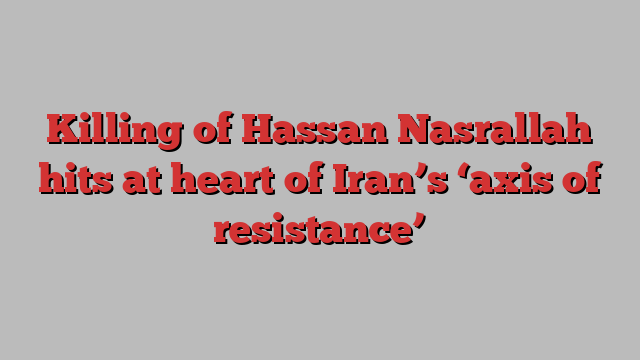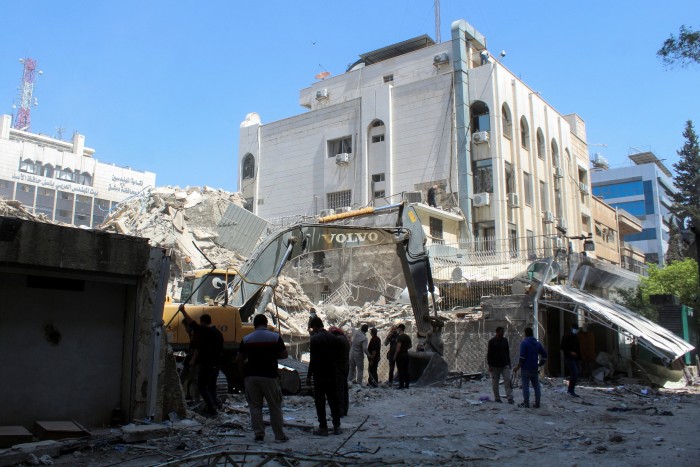
Within hours of Israel launching strikes to assassinate Hassan Nasrallah, large posters appeared across Tehran declaring “Hizbollah is Alive”.
Iranian state media initially said Nasrallah, the Lebanese militant group’s leader, was “in a safe place”, but there was a conspicuous silence from regime officials. It was as if the Islamic republic’s leaders were not ready to acknowledge the loss of Tehran’s most important regional ally.
Israel’s assassination of Nasrallah on Friday delivered not just a catastrophic blow to Hizbollah, but a devastating hit to its main patron: Iran. For more than three decades, Tehran looked to Nasrallah and his movement as the key pillar in its regional security and deterrent strategy — the frontline in its long shadow war with Israel.
An Iranian official said Ayatollah Ali Khamenei, Iran’s supreme leader and ultimate decision maker, considered Nasrallah a “son”.
“It’s a major blow to Iran, both tactically and strategically — the loss of such a figure who has had the absolute trust of the supreme leader,” the official said. “It doesn’t mean that Hizbollah is done . . . but it means it will take a long time to establish trust. Other leaders [in Hizbollah] were not as close as he was to the supreme leader. In the short term it’s a big, big blow to the whole resistance.”

Rebuilding Hizbollah’s leadership and operational strength will pose myriad challenges for Tehran, particularly as Israel’s operations have laid bare how deeply its intelligence services have penetrated both Lebanon and Iran.
Iranian analysts said the republic would not abandon its strategy of using proxy forces across the region, despite the setback. Iran has relied on regional militant groups since its 1980s war with Iraq, realising it lacked the conventional firepower to defend against its foes, including Israel and the US.
These forces — dubbed the axis of resistance — remain essential to Iran’s ability to project power beyond its borders, which is based in part on the belief that it can hurt its enemies without being drawn into direct conflict.
After enduring the worst two weeks in Hizbollah’s history, the instinct in Tehran has so far been to regroup rather than lash out. The Iranian official said Iran wanted to allay any perception it had been weakened, and instead show that “everything is under control”.
“Tehran views this as yet another difficult episode in a broader struggle that must continue,” said Mohammad Ali Abtahi, a former reformist vice-president. “Iran and Hizbollah may pause their actions for now to avoid escalating the conflict, but this should not be seen as a long-term retreat nor a change of strategy.”
Iran has nurtured Hizbollah as a proxy force in Lebanon since the 1980s, when Israel occupied the Arab state, and came to regard it as the most successful of its regional ventures.
The group served as a model for other Iran-backed Shia militias in Iraq and Syria, and the Houthis in Yemen, and also helped train them. Tehran’s Quds force, the wing of the elite Revolutionary Guards responsible for overseas operations, works hand-in-hand with the militants, providing arms, funds and training.
A senior guards commander, Abbas Nilforoushan, was killed along with Nasrallah when Israel bombs flattened at least six residential buildings in a southern suburb of Beirut.
That has heightened concerns in Israel that Iran could seek to retaliate, both for the assassination of Nasrallah and one of its own officers.
US national security spokesman John Kirby on Sunday expressed concern about a potential Iranian response, saying rhetoric coming out of Iran “certainly suggests they’re going to try to do something”.
But so far, there have been no vows of revenge from Iranian leaders. Instead, Tehran’s main message has been that while Hizbollah has taken a damaging hit, it remains a significant force.
“Hizbollah has lost a unique leader, but the foundations that he laid in Lebanon and provided for other resistance centres will not disappear with his loss, instead they will further strengthen, thanks to his, and other martyrs’ blood,” Khamenei said.
Tehran has over the past year made clear it does not want direct conflict with Israel, even as hostilities have escalated, wary of being drawn into what Iranian officials describe “as a trap”.
For years, Iran sought to keep its conflict with Israel in the shadows. But that delicate balance has been upended by the regional hostilities that erupted in the wake of Hamas’s October 7 attack. Iran-backed militants attacked Israel, while Israeli forces have repeatedly struck Iranian commanders in Syria.
In April, Tehran took the unprecedented step of launching more than 300 missiles and drones at Israel after Israeli forces attacked Iran’s consulate in Damascus, killing several senior Iranian commanders.

It was the first direct attack on Israel from Iranian soil. Regime leaders hoped it would set a new level of deterrence, although it was widely telegraphed to limit the damage and avoid further escalation, Iranian analysts say.
But Israel has appeared undeterred.
In July, Hamas political leader Ismail Haniyeh was assassinated in Tehran by a suspected Israeli attack just hours after he attended the inauguration of Iran’s President Masoud Pezeshkian — a humiliating security breach for the republic.
Despite vows of retaliation, Iran has yet to respond, underscoring the challenges it faces sustaining its deterrence strategy.
“We’ve reached a stage where neither missiles or drones nor proxy forces can effectively deter Israel, which enjoys cutting-edge technology and unwavering US financial support,” said a senior Iranian reformist politician.
“Iran appears reluctant to engage in direct conflict, especially with a leader like [Israeli Prime Minister Benjamin] Netanyahu, who uses aggressive tactics to appear uncontrollable. Why should Iran fight with a madman and risk the whole country?”
Tehran’s apparent hesitation could prove politically costly. As the self-proclaimed leader of anti-Israel movements in the Islamic world, the Iranian regime is under increasing pressure to act.
In Lebanon, anger towards Iran is growing. Social media is rife with posts accusing the regime of betrayal for not responding swiftly to Nasrallah’s killing.
“Iran will become a symbol of treason in history, like Judas and Brutus,” read one post that went viral.
Compounding Iran’s challenges is the fact that Pezeshkian, Iran’s first reformist president in two decades, wants to ease tensions with the US and negotiate over its nuclear programme to secure relief from sanctions.
But any détente with the west, which would ease crippling economic hardship, becomes even more complicated with every escalation.
“Iran, weakened by US sanctions, cannot afford a war with Israel,” said one political analyst in Tehran. “This is exactly why Israel is trying to draw Iran into a war.”
The risk of Israel turning its sights to the republic has raised concerns in Tehran. Iranians also worry that Netanyahu’s strategy is to scupper any chances of Washington engaging with Iran, while drawing the US into a war against the republic.
The “criminal and racist gang of Netanyahu . . . might even attack Iran”, warned Mohsen Rezaei, a former senior guards’ commander, on Saturday.
For now, the republic appears set on sticking to its policy of restraint, avoiding direct clashes while potentially using other militants such as the Houthis to attack Israel and the US. “The Houthis have already destabilised shipping routes in the Red Sea,” added the senior reformist politician.
Iran can also be expected to patiently assist Hizbollah in rebuilding, in the hope of guiding it through the most difficult period since its foundation. But the loss of the group’s leader and senior commanders could further radicalise a reborn Hizbollah.
“Hizbollah, post-Nasrallah, may no longer pursue the same calculations and policies. On the contrary, it can become more radical,” Abtahi added. “This is no end to Hizbollah nor Iran’s influence in the region.”
Additional reporting by Raya Jalabi in Beirut and Steff Chávez in Washington